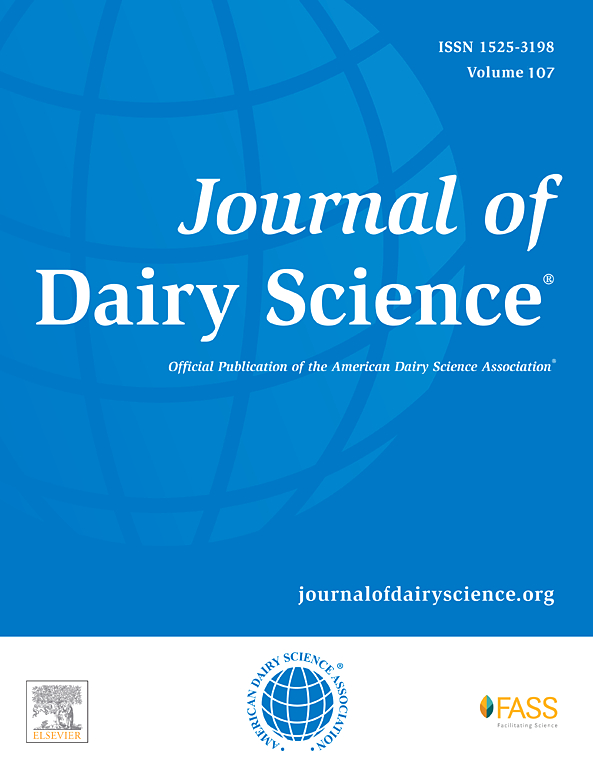日粮中两种浓度的α-淀粉酶酶解玉米粒对奶牛泌乳性能、咀嚼活动、瘤胃发酵、养分消化率和氮分配的影响。
IF 4.4
1区 农林科学
Q1 AGRICULTURE, DAIRY & ANIMAL SCIENCE
引用次数: 0
摘要
本试验研究了α-淀粉酶使能玉米(AAC)在2种浓度下对青贮成熟玉米粒饲粮的影响。20头单独饲养的荷斯坦奶牛,被安排在4 × 4拉丁方格中(每21天),以2 × 2因子组合暴露于玉米浓度(C)的4个处理中:高(28.7%淀粉,24.6%玉米,2.5%柑橘果肉)vs低(21.5%淀粉,14.1%玉米,13.8%柑橘果肉)和类型(T): AAC(48.8%玻璃体)vs等基因对照(CTL)。51.1%透明状态)。每周磨粒,水化(AAC为62.2±1.3% DM, CTL为63.1±1.4% DM),青贮28±3 d。统计模型具有平方、牛(方)、周期、C、T和C × T互作效应。处理对产奶量(34.1 kg/d)和DMI (22.8 kg/d)无影响。高玉米降低了日脂肪产量(1.209 vs 1.297 kg/d)和ECM (33.2 vs 34.4 kg/d),提高了乳蛋白浓度(3.12 vs 3.09%)。饲喂Low时,AAC相对于CTL增加ECM/DMI (1.54 vs 1.49)。高aac组的用餐频率(9.8顿/d)低于低aac组(10.3顿/d)。高玉米日采食量比低玉米日采食量大(49.9% vs 44.4%),日首餐持续时间长(69.7 vs 62.0 min)。AAC有提高全道NDF消化率的趋势(49.9% vs 48.0%),但淀粉消化率没有差异(98.4%)。瘤胃微生物产量无显著差异(尿囊素为335 mmol/d)。与低玉米相比,高玉米降低了瘤胃乙酸丙酸比(2.45 vs 2.95)和pH (6.59 vs 6.74)。高aac饲粮的MUN低于低aac饲粮(17.4 vs 18.8 mg/dL),高aac饲粮的血浆尿素- n低于高ctl和低aac饲粮(分别为17.2、19.0和18.7 mg/dL)。与低淀粉相比,高淀粉降低了尿氮排泄量(g/d)和分配(占日氮摄入量的百分比),也倾向于减少粪便氮的排泄和分配。总体而言,低淀粉增加了乳固体产量、尿液和粪便中N的损失以及瘤胃乙酸/丙酸比。饲喂AAC和Low的奶牛的饲料效率最高,饲喂AAC和High的奶牛的总排泄物氮摄入比例最低。本文章由计算机程序翻译,如有差异,请以英文原文为准。
Effect of ensiled alpha-amylase–enabled corn grain at 2 concentrations in the diet on lactation performance, chewing activity, ruminal fermentation, nutrient digestibility, and nitrogen partition of dairy cows
This experiment evaluated the effect of α-amylase–enabled corn (AAC) on cows fed ensiled mature kernels at 2 concentrations in the diet. Twenty individually housed Holstein cows, arranged in 4 × 4 Latin squares (with 21-d periods), were exposed to each of 4 treatments in a 2 × 2 factorial combination of corn concentration (C): high corn concentration (High; 28.7% starch, 24.6% corn, 2.5% citrus pulp) versus low corn concentration (Low; 21.5% starch, 14.1% corn, 13.8% citrus pulp) and type (T): AAC (48.8% vitreousness) versus isogenic control (CTL; 51.1% vitreousness). Kernels were ground weekly, hydrated (62.2 ± 1.3% DM on AAC and 63.1 ± 1.4% DM on CTL), and ensiled for 28 ± 3 d. The statistical model had the effects of square, cow (square), period, C, T, and the C × T interaction. No effect of treatment was detected for milk yield (34.1 kg/d) and DMI (22.8 kg/d). High corn reduced the daily yield of fat (1.209 kg/d vs. 1.297 kg/d) and ECM (33.2 kg/d vs. 34.4 kg/d) and increased milk protein concentration (3.12% vs. 3.09%). When fed with Low, AAC increased ECM/DMI relative to CTL (1.54 vs. 1.49). Meal frequency was reduced on High-AAC (9.8 meals/d) relative to Low-AAC (10.3 meals/d). Cows fed High had greater proportion of daily intake in the morning (49.9% vs. 44.4%) and longer duration of the first daily meal (69.7 min vs. 62.0 min) than cows fed Low. There was a tendency for AAC to increase the total-tract NDF digestibility (49.9% vs. 48.0%), but starch digestibility did not differ (98.4%). Ruminal microbial yield did not differ (335 mmol/d of allantoin in urine). High reduced the ruminal acetate to propionate ratio (2.45 vs. 2.95) and pH (6.59 vs. 6.74) relative to Low. Cows fed High-AAC had lower MUN than Low-AAC (17.4 mg/dL vs. 18.8 mg/dL), and plasma urea-N was lower on High-AAC than on High-CTL and Low-AAC (17.2, 19.0, and 18.7 mg/dL, respectively). High starch reduced urine-N excretion (g/d) and partition (% of daily N intake) relative to Low starch and also tended to reduce fecal-N excretion and partition. Overall, Low starch increased milk solids yield, N loss in urine and feces, and the ruminal acetate to propionate ratio. Cows fed AAC and Low had the highest feed efficiency, and cows fed AAC and High had the lowest proportion of N intake in total excreta.
求助全文
通过发布文献求助,成功后即可免费获取论文全文。
去求助
来源期刊

Journal of Dairy Science
农林科学-奶制品与动物科学
CiteScore
7.90
自引率
17.10%
发文量
784
审稿时长
4.2 months
期刊介绍:
The official journal of the American Dairy Science Association®, Journal of Dairy Science® (JDS) is the leading peer-reviewed general dairy research journal in the world. JDS readers represent education, industry, and government agencies in more than 70 countries with interests in biochemistry, breeding, economics, engineering, environment, food science, genetics, microbiology, nutrition, pathology, physiology, processing, public health, quality assurance, and sanitation.
 求助内容:
求助内容: 应助结果提醒方式:
应助结果提醒方式:


